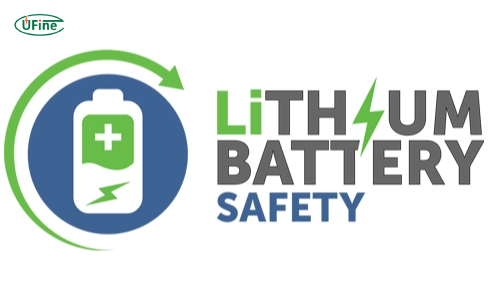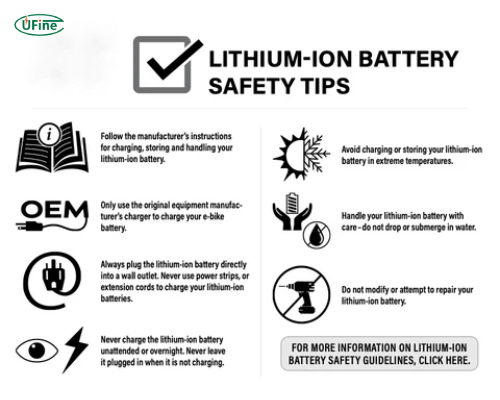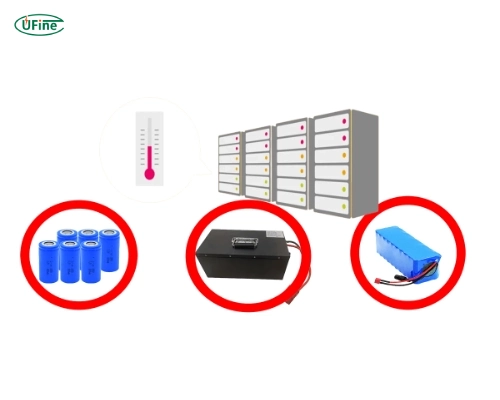Lithium-ion batteries have become ubiquitous daily, powering everything from smartphones to electric vehicles. However, with their widespread use comes the critical need for understanding lithium-ion battery safety. In this comprehensive guide, we’ll delve into the intricacies of lithium-ion batteries, explore potential hazards, and provide actionable tips to ensure safety.
Part 1. What is a lithium-ion battery?
Lithium-ion batteries are rechargeable energy storage devices that utilize lithium ions moving between the anode and cathode to store and release energy. These batteries are preferred for their high energy density, low weight, and long cycle life, making them ideal for portable electronics and electric vehicles.
Components of a Lithium-Ion Battery
A typical lithium-ion battery consists of the following components:
- Anode (Negative Electrode): Usually made of graphite, this material stores lithium ions during charging.
- Cathode (Positive Electrode): Made of lithium metal oxides, which release lithium ions during discharge.
- Electrolyte: A lithium salt solution that facilitates the movement of ions between the anode and cathode.
- Separator: A porous membrane that prevents direct contact between the anode and cathode, avoiding short circuits.
Part 2. How lithium-ion batteries work?
In a lithium-ion battery, lithium ions move from the anode to the cathode during discharge and back when charging. This movement creates the electrical energy that powers devices. The electrolyte facilitates the flow of ions, while the separator prevents short circuits by keeping the anode and cathode apart.
Part 3. Common applications of lithium-ion batteries
Various applications use lithium-ion batteries due to their efficiency and reliability. Here are some common uses:
- Consumer Electronics: Smartphones, laptops, tablets, and smartwatches.
- Electric Vehicles (EVs): Powering the motors and systems of electric cars and bikes.
- Energy Storage Systems: Storing energy from renewable sources like solar and wind.
- Power Tools: Providing reliable power for cordless drills, saws, and other tools.
Part 4. Potential hazards of lithium-ion batteries
While lithium-ion batteries are generally safe, they can pose certain risks if not handled properly. Understanding these hazards can help you take the necessary precautions.
Overcharging
Overcharging occurs when you charge a battery beyond its maximum capacity. This can lead to excessive heat buildup, causing thermal runaway—a condition where the battery’s temperature increases uncontrollably, potentially leading to fires or explosions. Always use manufacturer-approved chargers and avoid leaving batteries plugged in overnight.
Physical Damage
Physical damage to a lithium-ion battery, such as puncturing or crushing, can cause internal short circuits. This can lead to overheating, fires, or explosions. Handle batteries with care and avoid dropping them.
Exposure to High Temperatures
High temperatures can accelerate the chemical reactions inside a battery, leading to thermal runaway. Store batteries in cool, dry places and avoid leaving them in hot environments like parked cars or direct sunlight.
Manufacturing Defects
Defects during the manufacturing process can lead to safety issues. These defects might not be immediately apparent but can cause problems over time. Purchase batteries from reputable manufacturers and stay informed about recalls or safety notices.
Part 5. Best practices for lithium-ion battery safety
To ensure the safe use of lithium-ion batteries, follow these best practices:
Proper Storage
- Store in a Cool, Dry Place: High temperatures and humidity can degrade battery performance and safety.
- Partial Charge Storage: If storing for an extended period, keep the battery at around 50% charge to prolong its lifespan.
- Avoid Metal Objects: Store batteries separately to prevent accidental short circuits caused by contact with metal objects.
Safe Charging
- Use Approved Chargers: Manufacturer-approved chargers ensure compatibility and safety.
- Monitor Charging: Avoid leaving batteries unattended while charging.
- Avoid Overcharging: Unplug the charger once the battery reaches full charge to prevent heat buildup.
Handling and Disposal
- Handle with Care: Avoid dropping, puncturing, or crushing batteries.
- Recycle Responsibly: Lithium-ion batteries contain hazardous materials and should be disposed of at designated recycling centers to prevent environmental harm.
Part 6. Identifying a failing lithium-ion battery
Recognizing the signs of a failing battery can help prevent accidents. Here are some warning signs to watch for:
Swelling or Bulging
If a battery appears swollen or bulging, it indicates internal damage or gas buildup. Discontinue use immediately and replace the battery.
Excessive Heat
A battery that becomes unusually hot during use or charging may be failing. Stop using the device and inspect the battery.
Reduced Performance
If a battery’s performance declines significantly—such as a shortened lifespan or inability to hold a charge—it may be nearing the end of its life cycle. **Consider replacing the battery** to avoid potential hazards.
Part 7. Emergency procedures for lithium-ion battery incidents
Despite taking precautions, accidents can still happen. Knowing how to respond to lithium-ion battery incidents is crucial for minimizing damage and ensuring safety.
Immediate Actions
- Evacuate the Area: If a battery begins to smoke, swell, or catch fire, evacuate immediately to avoid inhaling toxic fumes.
- Call Emergency Services: Contact local emergency services to report the incident and get professional assistance.
Fire Extinguishing
- Use a Class D Fire Extinguisher: Classify lithium-ion battery fires as Class D fires (metal fires). Use a Class D fire extinguisher designed explicitly for such fires.
- Avoid Water: Water can react with lithium, potentially worsening the fire. Instead, use sand or a fire blanket if a Class D extinguisher is unavailable.
Part 8. FAQs
-
Can lithium-ion batteries explode?
Yes, lithium-ion batteries can explode, but it is rare. Explosions typically occur due to manufacturing defects, damage, overcharging, or exposure to high temperatures. Proper use and care can significantly reduce the risk of explosions. Follow manufacturer guidelines and avoid exposing batteries to extreme conditions. -
How can I tell if my lithium-ion battery is damaged?
Signs of a damaged lithium-ion battery include swelling, leakage, discoloration, or unusual smells. If your battery gets excessively hot during use or charging, this can also be a sign of damage. If you notice these signs, stop using the battery immediately and replace it. -
How long do lithium-ion batteries last?
The lifespan of a lithium-ion battery depends on usage, charging habits, and environmental conditions. On average, these batteries last between 2 to 3 years or 300 to 500 charge cycles. To extend the lifespan, avoid overcharging, overheating, and deep discharges. -
Is it safe to leave lithium-ion batteries on the charger overnight?
Leaving lithium-ion batteries on the charger overnight is generally safe if the charger has an automatic shut-off feature. However, avoiding leaving them plugged in for extended periods is best. Overcharging can shorten battery lifespan and increase the risk of overheating. Always use a high-quality charger with safety features.
Related Tags:
More Articles

LiPo Battery Discharge Rate Guide & Calculation Tips
Understand LiPo battery discharge rates, C-ratings, and how to calculate max current. Essential guide for RC, drones, and electronics users.
High‑Capacity 3S LiPo Batteries: 5000 mAh vs. 10000 mAh
Compare 3S LiPo 5000mAh vs 10000mAh batteries by weight, power, and use. Find the best fit for your drone, RC car, or boat setup.
Top 5 Applications for Small 3S LiPo Batteries
Small 3S LiPo batteries power drones, RC gear, wearables, and robotics with high energy and low weight. Making them ideal for compact electronics projects.
Building and Charging Your Own 3S LiPo Pack: A Step‑by‑Step Guide
Learn how to build, balance, and charge a 3S LiPo battery pack safely at home with this complete DIY guide for hobbyists and beginners.
How to Choose the Right LiPo Battery Plug Type?
Discover the best LiPo battery plug types, how to choose them, and expert tips for safe usage, soldering, and maintenance.






